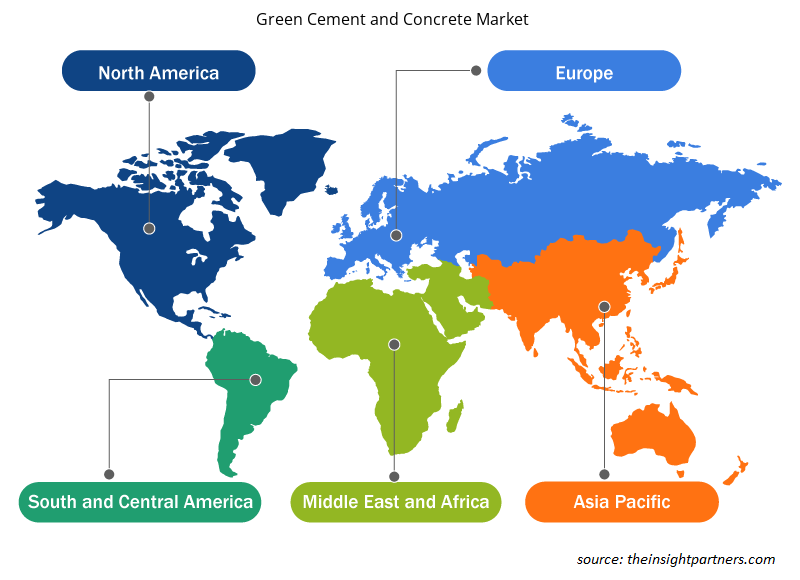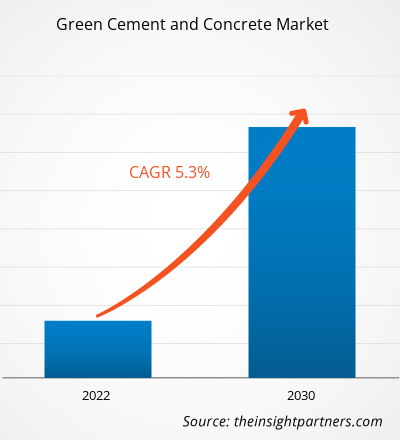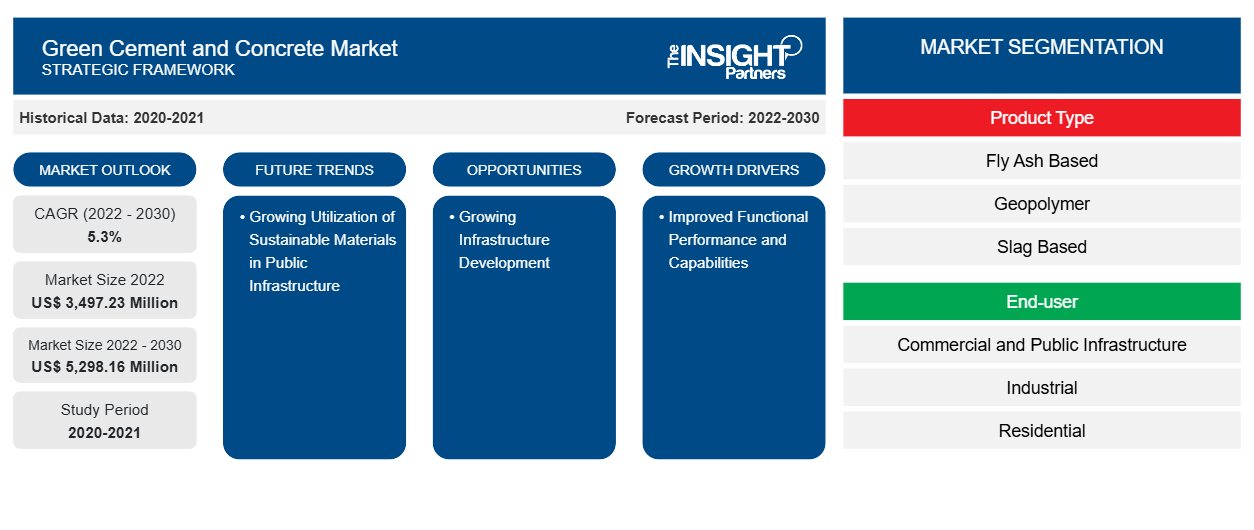预计到 2030 年,绿色水泥和混凝土市场规模将从 2022 年的 34.9723 亿美元增至 52.9816 亿美元。预计 2022-2030 年市场复合年增长率为 5.3%。许多国家正在实施水泥行业脱碳路线图,这推动了全球对绿色水泥和混凝土的需求。
绿色水泥和混凝土市场分析
水泥行业是主要的碳排放行业之一,预计会对环境保护产生负面影响。因此,人们越来越关注减轻碳对环境的影响,并注重增加可持续性方法,预计将推动全球绿色水泥和混凝土市场的增长。
绿色水泥和混凝土市场概况
政府的不断举措和鼓励政策预计将推动可持续绿色水泥和混凝土在公共基础设施基础中的应用。例如,印度即将实施的几项基础设施项目,如纳尔马达河谷开发项目、Bharatmala Pariyojana、杰纳布河铁路桥、孟买跨海港连接线、德里地铁工业走廊和新孟买国际项目,预计将使用绿色水泥和混凝土建造。因此,绿色水泥作为传统水泥的可行替代品日益普及,预计将使其在商业和公共基础设施领域的应用保持增长。
定制此报告以满足您的需求
您可以免费定制任何报告,包括本报告的部分内容、国家级分析、Excel 数据包,以及为初创企业和大学提供优惠和折扣
-
获取此报告的关键市场趋势。这个免费样品将包括数据分析,从市场趋势到估计和预测。
绿色水泥和混凝土市场驱动因素和机遇
功能性能和性能的提高推动绿色水泥和混凝土的需求
生产标准水泥的过程中需要大量的天然气用于加热。绿色水泥是由工业副产品制成的,这使得生产过程更加节能。与其他标准水泥相比,绿色水泥具有更高的耐火性,凝固时间更短。使用绿色水泥建造的建筑物寿命更长。绿色水泥的生产过程遵循高端技术,可以减少碳排放,减少污染。生产绿色水泥需要使用高炉矿渣、粉煤灰硅和铁等副产品,这些产品具有成本效益。绿色水泥的特性中含有 0.5-0.6% 的二氧化铁,这为水泥的坚固性和颜色提供了强度。这种水泥干得快,收缩率极小。它经久耐用,是环境更可持续的替代品。绿色水泥还具有高端隔热和防火性能。绿色水泥是道路、桥梁和机场等人流量大区域的更合适的替代品,因为它可以支撑重物。因此,绿色水泥在耐久性、强度和抵抗力方面的更高性能水平和能力推动了市场的发展。
基础设施建设不断增长——绿色水泥和混凝土市场的机会
可持续基础设施资金的增加为绿色水泥和混凝土的发展开辟了道路,促进了环保替代品的利用,促进了经济发展。它还为各国提供了一条途径,通过参与减少碳排放的项目,包括可持续和绿色建筑和制造生态系统,将其基础设施发展与气候目标结合起来。建筑和基础设施行业正致力于减少碳足迹,因为它是环境污染的主要因素。因此,基础设施发展中对绿色水泥和混凝土的日益关注预计将为市场提供巨大的机会。
绿色水泥和混凝土市场报告细分分析
有助于得出绿色水泥和混凝土市场分析的关键部分是产品类型和最终用户。
- 根据产品类型,绿色水泥和混凝土市场分为粉煤灰基、土聚物基、矿渣基和其他。粉煤灰基细分市场在 2022 年占据了较大的市场份额。
- 根据最终用户,绿色水泥和混凝土市场分为商业和公共基础设施、工业和住宅。商业和公共基础设施部门在 2022 年占据了更大的市场份额。
绿色水泥和混凝土市场份额按地区分析
绿色水泥和混凝土市场报告的地理范围主要分为五个地区:北美、亚太、欧洲、中东和非洲、南美/南美和中美。
日益增长的环境问题以及水泥行业对可持续替代品的利用的关注推动了亚太地区绿色水泥和混凝土市场的增长。中国和印度等主要水泥生产国已认识到需要向更环保的水泥生产方式转型。此外,各国政府正在采取各种措施吸引基础设施开发项目的私人融资。住宅和商业建筑项目投资的不断扩大正在推动亚太国家对包括绿色水泥和混凝土解决方案在内的先进建筑材料的需求。
绿色水泥和混凝土市场区域洞察
Insight Partners 的分析师已详细解释了预测期内影响绿色水泥和混凝土市场的区域趋势和因素。本节还讨论了北美、欧洲、亚太地区、中东和非洲以及南美和中美洲的绿色水泥和混凝土市场细分和地理位置。

- 获取绿色水泥和混凝土市场的区域具体数据
绿色水泥和混凝土市场报告范围
| 报告属性 | 细节 |
|---|---|
| 2022 年市场规模 | 34.9723亿美元 |
| 2030 年的市场规模 | 52.9816亿美元 |
| 全球复合年增长率(2022 - 2030 年) | 5.3% |
| 史料 | 2020-2021 |
| 预测期 | 2022-2030 |
| 涵盖的领域 |
按产品类型
|
| 覆盖地区和国家 |
北美
|
| 市场领导者和主要公司简介 |
|
绿色水泥和混凝土市场参与者密度:了解其对业务动态的影响
绿色水泥和混凝土市场正在快速增长,这得益于终端用户需求的不断增长,而这些需求又源于消费者偏好的不断变化、技术进步以及对产品优势的认识不断提高等因素。随着需求的增加,企业正在扩大其产品范围,进行创新以满足消费者的需求,并利用新兴趋势,从而进一步推动市场增长。
市场参与者密度是指在特定市场或行业内运营的企业或公司的分布情况。它表明在给定市场空间中,相对于其规模或总市场价值,有多少竞争对手(市场参与者)存在。
在绿色水泥和混凝土市场运营的主要公司有:
- ACC水泥(阿达尼集团)
- 中国建筑材料股份有限公司(CNBM)
- 绿色水泥公司
- 安徽海螺水泥
- 霍尔希姆有限公司
- JSW水泥有限公司
免责声明:上面列出的公司没有按照任何特定顺序排列。

- 了解绿色水泥和混凝土市场的主要参与者概况
绿色水泥和混凝土市场新闻和最新发展
绿色水泥和混凝土市场通过收集一级和二级研究后的定性和定量数据进行评估,其中包括重要的公司出版物、协会数据和数据库。以下是市场创新、业务扩展和战略发展情况的列表:
- 2023 年 2 月,Holcim 在法国 Saint-Pierre-la-Cour 工厂启动了欧洲首个煅烧粘土水泥业务,生产出 ECOPlanet 绿色水泥,与标准水泥 (CEM I) 相比,其二氧化碳排放量减少了 50%。(来源:Holcim Ltd.,新闻稿/公司网站/通讯)
- 2023 年 9 月,霍夫曼绿色水泥技术公司与 Point. P 签署了合作协议。根据协议条款,HGCT 的无熟料水泥产品将分销给 Point. P 的预拌混凝土 (RMC) 和配料厂。(来源:霍夫曼绿色水泥技术公司,新闻稿/公司网站/通讯)
绿色水泥和混凝土市场报告范围和交付成果
《绿色水泥和混凝土市场规模和预测(2020-2030年)》报告对市场进行了详细的分析,涵盖以下领域:
- 范围内涵盖的所有主要细分市场的全球、区域和国家层面的绿色水泥和混凝土市场规模和预测
- 市场动态,如驱动因素、限制因素和关键机遇
- 绿色水泥和混凝土市场趋势
- 详细的 PEST 和 SWOT 分析
- 绿色水泥和混凝土市场分析涵盖主要市场趋势、全球和区域框架、主要参与者、法规和最新市场发展
- 绿色水泥和混凝土行业格局和竞争分析,涵盖市场集中度、热点图分析、知名企业和最新发展
- 详细的公司简介
- 历史分析(2 年)、基准年、预测(7 年)及复合年增长率
- PEST和SWOT分析
- 市场规模、价值/数量 - 全球、区域、国家
- 行业和竞争格局
- Excel 数据集
近期报告
客户评价
购买理由
- 明智的决策
- 了解市场动态
- 竞争分析
- 客户洞察
- 市场预测
- 风险规避
- 战略规划
- 投资论证
- 识别新兴市场
- 优化营销策略
- 提升运营效率
- 顺应监管趋势























 获取免费样品 - 绿色水泥和混凝土市场
获取免费样品 - 绿色水泥和混凝土市场